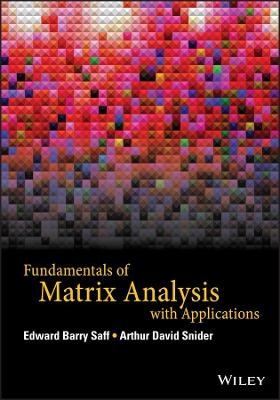
Fundamentals of Matrix Analysis with Applications
John Wiley & Sons Inc (Verlag)
978-1-118-95365-5 (ISBN)
An accessible and clear introduction to linear algebra with a focus on matrices and engineering applications
Providing comprehensive coverage of matrix theory from a geometric and physical perspective, Fundamentals of Matrix Analysis with Applications describes the functionality of matrices and their ability to quantify and analyze many practical applications. Written by a highly qualified author team, the book presents tools for matrix analysis and is illustrated with extensive examples and software implementations.
Beginning with a detailed exposition and review of the Gauss elimination method, the authors maintain readers’ interest with refreshing discussions regarding the issues of operation counts, computer speed and precision, complex arithmetic formulations, parameterization of solutions, and the logical traps that dictate strict adherence to Gauss’s instructions. The book heralds matrix formulation both as notational shorthand and as a quantifier of physical operations such as rotations, projections, reflections, and the Gauss reductions. Inverses and eigenvectors are visualized first in an operator context before being addressed computationally. Least squares theory is expounded in all its manifestations including optimization, orthogonality, computational accuracy, and even function theory. Fundamentals of Matrix Analysis with Applications also features:
Novel approaches employed to explicate the QR, singular value, Schur, and Jordan decompositions and their applications
Coverage of the role of the matrix exponential in the solution of linear systems of differential equations with constant coefficients
Chapter-by-chapter summaries, review problems, technical writing exercises, select solutions, and group projects to aid comprehension of the presented concepts
Fundamentals of Matrix Analysis with Applications is an excellent textbook for undergraduate courses in linear algebra and matrix theory for students majoring in mathematics, engineering, and science. The book is also an accessible go-to reference for readers seeking clarification of the fine points of kinematics, circuit theory, control theory, computational statistics, and numerical algorithms.
EDWARD BARRY SAFF, PhD, is Professor of Mathematics and Director of the Center for Constructive Approximation at Vanderbilt University. Dr. Saff is an Inaugural Fellow of the American Mathematical Society, Foreign Member of the Bulgarian Academy of Science, and the recipient of both a Guggenheim and Fulbright Fellowship. He is Editor-in-Chief of two research journals, Constructive Approximation and Computational Methods and Function Theory, and has authored or coauthored over 250 journal articles and eight books. Dr. Saff also serves as an organizer for a sequence of international research conferences that help to foster the careers of mathematicians from developing countries. ARTHUR DAVID SNIDER, PhD, PE, is Professor Emeritus at the University of South Florida, where he served on the faculties of the Departments of Mathematics, Physics, and Electrical Engineering. Previously an analyst at the Massachusetts Institute of Technology's Draper Lab and recipient of the USF Krivanek Distinguished Teacher Award, he consults in industry and has authored or coauthored over 100 journal articles and eight books. With the support of the National Science Foundation, Dr. Snider also pioneered a course in fine art appreciation for engineers.
Preface ix
Part I Introduction: Three Examples 1
1 Systems of Linear Algebraic Equations 5
1.1 Linear Algebraic Equations 5
1.2 Matrix Representation of Linear Systems and the Gauss-Jordan Algorithm 17
1.3 The Complete Gauss Elimination Algorithm 27
1.4 Echelon Form and Rank 38
1.5 Computational Considerations 46
1.6 Summary 55
2 Matrix Algebra 58
2.1 Matrix Multiplication 58
2.2 Some Physical Applications of Matrix Operators 69
2.3 The Inverse and the Transpose 76
2.4 Determinants 86
2.5 Three Important Determinant Rules 100
2.6 Summary 111
Group Projects for Part I
A. LU Factorization 116
B. Two-Point Boundary Value Problem 118
C. Electrostatic Voltage 119
D. Kirchhoff’s Laws 120
E. Global Positioning Systems 122
F. Fixed-Point Methods 123
Part II Introduction: The Structure of General Solutions to Linear Algebraic Equations 129
3 Vector Spaces 133
3.1 General Spaces Subspaces and Spans 133
3.2 Linear Dependence 142
3.3 Bases, Dimension, and Rank 151
3.4 Summary 164
4 Orthogonality 165
4.1 Orthogonal Vectors and the Gram–Schmidt Algorithm 165
4.2 Orthogonal Matrices 174
4.3 Least Squares 180
4.4 Function Spaces 190
4.5 Summary 197
Group Projects for Part II
A. Rotations and Reflections 201
B. Householder Reflectors 201
C. Infinite Dimensional Matrices 202
Part III Introduction: Reflect on This 205
5 Eigenvectors and Eigenvalues 209
5.1 Eigenvector Basics 209
5.2 Calculating Eigenvalues and Eigenvectors 217
5.3 Symmetric and Hermitian Matrices 225
5.4 Summary 232
6 Similarity 233
6.1 Similarity Transformations and Diagonalizability 233
6.2 Principle Axes and Normal Modes 244
6.3 Schur Decomposition and Its Implications 257
6.4 The Singular Value Decomposition 264
6.5 The Power Method and the QR Algorithm 282
6.6 Summary 290
7 Linear Systems of Differential Equations 293
7.1 First-Order Linear Systems 293
7.2 The Matrix Exponential Function 306
7.3 The Jordan Normal Form 316
7.4 Matrix Exponentiation via Generalized Eigenvectors 333
7.5 Summary 339
Group Projects for Part III
A. Positive Definite Matrices 342
B. Hessenberg Form 343
C. Discrete Fourier Transform 344
D. Construction of the SVD 346
E. Total Least Squares 348
F. Fibonacci Numbers 350
Answers to Odd Numbered Exercises 351
Index 393
| Erscheint lt. Verlag | 20.11.2015 |
|---|---|
| Verlagsort | New York |
| Sprache | englisch |
| Maße | 185 x 262 mm |
| Gewicht | 844 g |
| Themenwelt | Mathematik / Informatik ► Mathematik ► Algebra |
| Mathematik / Informatik ► Mathematik ► Analysis | |
| Mathematik / Informatik ► Mathematik ► Wahrscheinlichkeit / Kombinatorik | |
| Technik ► Elektrotechnik / Energietechnik | |
| ISBN-10 | 1-118-95365-7 / 1118953657 |
| ISBN-13 | 978-1-118-95365-5 / 9781118953655 |
| Zustand | Neuware |
| Informationen gemäß Produktsicherheitsverordnung (GPSR) | |
| Haben Sie eine Frage zum Produkt? |
aus dem Bereich


